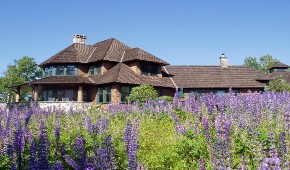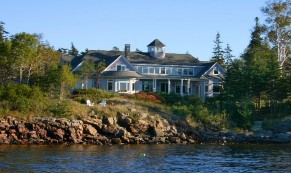This has been an interesting year for luxury real estate in Maine. As is true throughout the entire country, specific market areas have rebounded from the downturn with surprising strength and vigor, while others are still on a slow and steady climb from market lows.

A 5.5 acre compound on Brandy Pond, offering access to Sebago and Long Lakes. Sold by LandVest in September 2015 for $2,550,000.
Our three real estate offices here—in Northeast Harbor, Camden, and Portland—have all had productive years, and each tells a different tale about what’s happening in high-end real estate. When we look back on the last ten years, we see distinct variations in the three markets, as illustrated by the chart on the following page.
 Hidden Court in Cape Elizabeth, a 38-acre waterfront estate with a historic residence built in the style of a 14th century English manor. Sold by LandVest in May 2015 for $4,478,350. Hidden Court in Cape Elizabeth, a 38-acre waterfront estate with a historic residence built in the style of a 14th century English manor. Sold by LandVest in May 2015 for $4,478,350.
|
The market crash of 2008 hit southern Maine (which we’re defining as the coastal towns from Wiscasset south, plus the inland lakes near Portland) hard, though certainly not as hard as other parts of the country, where speculation had inflated a massive bubble. Still, sales of properties at the top of the market declined sharply. For three years following, the market remained depressed, with greatly diminished activity. In 2011, sales took a dramatic turn and began to climb. They’ve been on the rise ever since, and the number of sales in this region is now up above the highest levels set in 2005- 2006.
 Johns Island, a 21-acre island in Bristol, with a historic six-bedroom residence, guest houses, wharf, and deepwater dock. Sold by LandVest in June 2015 for $2,025,000. Johns Island, a 21-acre island in Bristol, with a historic six-bedroom residence, guest houses, wharf, and deepwater dock. Sold by LandVest in June 2015 for $2,025,000.
Compared to the baby boomers who dominated the million-plus pre-crash market, these buyers are young and mobile. They’re drawn to southern Maine for its ease of access to Boston, New York, Philadelphia, and DC. They’re attracted to the good schools, the restaurants, the arts and culture. And Maine’s quality of life, security, privacy, and unspoiled natural beauty continue to attract buyers who might have chosen Nantucket or the Hamptons instead fifteen years ago.

|
|
| In contrast, both the midcoast region (coastal communities and islands from Boothbay to Blue Hill) and the Mt. Desert area (Mt. Desert Island, Winter Harbor, Gouldsboro, and islands) have experienced the downturn differently. While both regions suffered a sharp drop in sales in 2008 just as southern Maine did, neither has shown the energetic recovery that southern Maine has.
As the chart above shows, both of these smaller markets have experienced a prolonged period of languor in the trough of the economic cycle, with sales numbers bouncing along the bottom, and a much less emphatic recovery. Sales started to pick up in the midcoast region in 2011, just as they did in southern Maine, but after a spike in 2014, this year is closing lower. With just 21 sales this year, we’re down from last year, and we’re below half of the 44 sales we saw at the market’s peak in 2006.

Harbor Point on Deer Isle, a 3-bedroom residence on an 11+ acre point of land with 1,760 feet of shorefront on East Penobscot Bay. Sold by LandVest in January 2015 for $2,850,000.
The Mt. Desert area, and specifically Mt. Desert Island with Acadia National Park, is a market unto itself, with characteristics and trends that sometimes diverge from other coastal communities. In 2008, these communities saw a steep drop in the upper end of the real estate market, and while there has been some improvement since 2012, the number of sales this year (14) is down from last year and still a long way off the market high of 24 in 2005.
A year ago, we saw the Portland recovery in full swing and suggested that the activity would |

Ocean Edge in Owls Head, a four-bedroom residence in an excellent neighborhood with 200+ feet of frontage, access to substantial deepwater wharf and tennis court. Sold by LandVest in October 2015 for $1,350,000.
likely make its way up the coast as the continued demand and shrinking inventory drives buyers downeast, as has historically been the case. We are still anticipating that this will happen, but the timing is anybody’s guess.
We’re encouraged by the deals we’ve done this year, which help show that Maine remains extremely attractive to high-end buyers. As we work our way through this shifting economic and demographic cycle, we are confident that the upper reaches of the midcoast Maine real estate market will thrive once again.
In closing, a personal note from Shannon: After 11 years full-time with LandVest, I am cutting back to part-time, project-based work with the Camden office as I pursue a long-held and growing interest in international relief work and medicine. I’m very pleased to be able to continue working with LandVest on a limited basis while I complete a degree in nursing. My time here has been rich and rewarding, and it’s been a real pleasure and a privilege to work with all of you.
From all of us to all of you, wishing you a prosperous and happy new year.
 
Terry Sortwell, Shannon Thompson, Joseph Sortwell
|